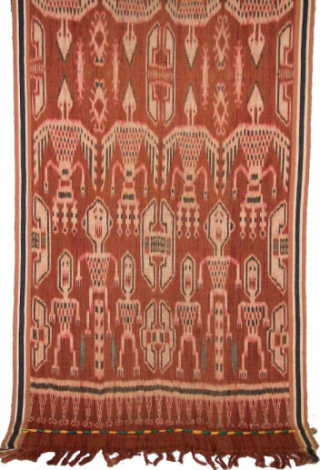Iban Textile
 This Iban ceremonial textile, known as pua kumbu, was made in the town of Kapit, in Sarawak, Malaysia, on the island of Borneo. The Iban people, known as the Sea Dayak during British colonial rule, are the largest ethnic group in the state of Sarawak.
This Iban ceremonial textile, known as pua kumbu, was made in the town of Kapit, in Sarawak, Malaysia, on the island of Borneo. The Iban people, known as the Sea Dayak during British colonial rule, are the largest ethnic group in the state of Sarawak.
Most pua kumbu are woven on back-strap looms by women. The decorative pattern is created by Ikat dying, a tie-dying process during which the individual threads are dyed before being woven. This pattern contains human-like figures known as engkaramba. In the past, these powerful figures could only be woven by wives and daughters of chiefs. They are representations of deities in the Iban’s shamanistic religion and can offer protection from danger. The act of weaving is a deeply spiritual undertaking that establishes an Iban weaver’s womanhood and status. Specific patterns like this one are often passed down from mother to daughter.
Pua kumbu translates as “grand blanket;” however, the pieces are very rarely used as sleeping blankets. Pua kumbu are recognized as sacred cloths throughout Iban mythology, dictating their use in rituals and ceremonies. In one creation myth, the pua kumba already existed at the beginning of time, and the first man and woman were brought to life by the Ancient God underneath it.
Although the cloths maintain these historic connections to shamanism, now the textiles also serve as a symbol of indigenous identity, separating the Iban from the majority Muslim Malay population.
